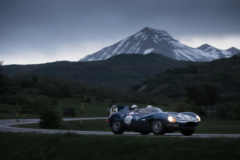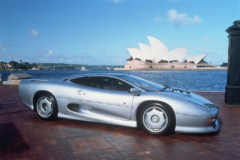In 1948, Jaguar introduced the illustrious XK120. Jaguar founder Sir William Lyons unveiled the Jaguar XK120 at the London Earls Court Motor Show in 1948. It was then the fastest production car in the world. His appealing lines, the flowing fenders and design appealed to the public. Thirteen years earlier, the SS was the very first car to carry the name Jaguar, and from that special model with the large headlights came an appealing sports model.
The Jaguar XK120, however, was the first independent model from the British manufacturer, and the XK120 was successful both on the road and on the circuit. This model kicked off Jaguars' impressive competition history. Ian Appleyard and his wife Pat, the daughter of founder Sir William Lyons, completed the heavy Coupe des Alpes from 1950 for three consecutive years with the Jaguar XK120 without penalty points. For their special achievements, they received the coveted Coupe d'Or (the golden trophy for participants who had not received any penalty in three consecutive editions of the rally). In 1951, the Appleyards and their XK 120 also won the heavy Tulip Rally - which ran throughout Europe - and the British RAC Rally.
C-Type in Le Mans
Inspired by the results at Le Mans in 1950, Jaguar invested a lot in its racing program. In 1951, the new Jaguar C-type (the XK120-C) immediately won the 24 hour race from Le Mans. Aerodynamics specialist Malcolm Sayer was responsible for the streamlined design of the Jaguar C-type. The C-type, considered by many to be the most beautiful car in the world, was the first car to win Le Mans at an average speed above the 160 km / hour.
From C-Type to D-type
Two years later, Jaguar was again successful with the C-type, thanks in part to the use of disc brakes - with which Jaguar had a scoop. Shortly thereafter, his successor, the Jaguar XK-D, dominated the race at Le Mans. From 1955, the Jaguar D-type won the 24 hour race three times in a row on the French circuit. The D-type was revolutionary due to its self-supporting construction, inspired by technology from the aviation industry. A lot of technology, such as the disc brakes and the engine, came from the Jaguar C-type.
Icon: the E-type
Later in the decade, restrictions on engine capacity put an end to the dominance at Le Mans. The brand again decided to focus exclusively on street cars. In 1961, Jaguar unveiled its sports car renaissance: the E-type (or XK-E). With its slender, self-supporting body, long bonnet and sporty 3.8 liter six-cylinder in-line engine, the Jaguar E-type has been a highly desirable sports car for three generations. Jaguar Special Operations recently returned the E-type as an electric car: the E-type Zero.
Seventies, eighties and nineties
The Jaguar XJ-S appeared in the mid-1970s. Tom Walkinshaw Racing (TWR) won the European Touring Car Championship with the XJ-S in 1984. Jaguar sold more than 21 copies of the XJ-S in 100.000 years. In 1992, Jaguar presented the XJ220, at the time - just like the XK120 - the fastest production car in the world. Four years later the Jaguar XK8 followed; Jaguar's best-selling sports car of the decade, and in several performance versions good for impressive results and winning award elections. In 2014, for example, the XK won the 'Best Performance Car Award.
On to the F-Type
In 2005 and 2006 the aluminum XK and XK-E appeared, designed by Jaguar's designer Ian Callum and in 2012 the Jaguar F-TYPE appeared. This last Jaguar sports car is considered the spiritual successor of the E-type.
The tribute: F-Type Convertible Rally
And two special copies of this F-Type are now being released. Both F-Type Convertible rally cars are equipped with the 2.0 liter Ingenium engine with 221 kW (300 hp) capacity and built in accordance with the strict FIA regulations. Under the supervision of Jaguar Design and Engineering, both cars received grooved brake discs and improved suspension. A roll cage, bucket seats with six-point seat belts, spot lights and a fire extinguishing system have also been installed. It is a tribute to the car that caused excitement for 70 years ago in London and today enjoys the status of a highly coveted classic.















If I remember correctly, a fire at the Jaguar factory was the reason that the D-type (in my opinion, the nicest sports coupe) had to leave the field prematurely as a result. The completely destroyed production lines were no longer equipped for the D-type after reconstruction, but for the accelerated E-type.
What a dry list of numbers and numbers! Are idd crazy beautiful cars, but what a stupid and stilted story!
Ed
Then you don't read it. There are also stories that are interesting.
In any case, it is a brief representation with background information of which we see the news value, and that also applies to the reason for the launch of the special F-Type versions. Of course we can tell a lot more about the Jaguar history, but the internet does not lend itself to very long contributions. That is why we have published the message in this way.